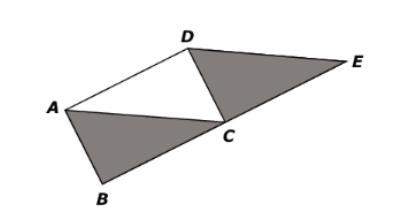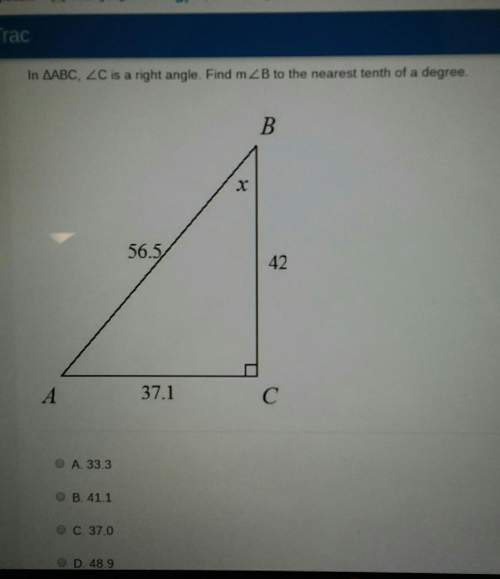
Mathematics, 24.11.2020 19:40 TheOriginal2x
To understand the corollary, consider what happens when three (or more) parallel lines intersect two transversals. You will use the GeoGebra geometry tool to investigate how multiple parallel lines divide transversals. Open GeoGebra, and complete each step below. If you need help, follow these instructions for using GeoGebra.
Part A
Construct three parallel lines. Then construct two arbitrary nonparallel transversals of the parallel lines. Make sure that the transversals cut the three parallel lines at distinct points. Mark the points of intersection where the transversals cut the parallel lines. Take a screenshot of your construction, save it, and insert the image below.
Part B
Notice that two line segments are formed on each transversal between the central parallel line and the outer parallel lines. Measure the lengths of the four line segments.
Part C
Calculate the ratio of the lengths of the two line segments formed on each transversal. You will have two sets of calculations. Round your answers to the hundredths place. What do you notice about the ratios of the lengths for each transversal? How do they compare?
Part D
Change the orientation of the transversals, and calculate the ratios again. Based on the new ratios, what can you conclude about three or more parallel lines that intersect two transversals?
Part E
State your conclusion in the form of a theorem, and then prove the theorem using a two-column proof. When you write the proof, refer to the diagram you created in part A. It will be helpful to use point labels to state what is given and what you have to prove and to use those labels throughout the proof.
As part of the proof, you’ll have to construct a line segment connecting the top intersection point on one of the transversals with the lowest intersection point of the other transversal, thus forming two triangles. Take a screenshot of the construction, save it, and insert the image in the space below before you begin your written proof.
Question 2
Now you’ll look at how an angle bisector of a triangle divides the side opposite to the angle. Reopen GeoGebra, and complete each step below.
Part A
Construct a random triangle, , and construct the angle bisector of . The angle bisector divides the opposite side, , into two line segments. Mark the point where the angle bisector intersects , and label it D. To verify that you have bisected the angle, measure and and display the angle measures. Take a screenshot of your construction, save it, and insert the image below.
Part B
Record the measurements for line segments of AB, BC, AD, and DC .
Part C
Calculate the ratio of AB to BC and the ratio of AD to DC. Round your answers to the hundredths place. What do you notice about the ratios?
Part D
Based on the ratios in part C, what can you conclude about the angle bisector?
Part E
Now write your conclusion in part D as a theorem, and prove the theorem using a two-column proof. When you write the proof, refer to the diagram you created in part A. As part of the proof, you will have to construct a line through point A parallel to . Mark the point where the new line intersects the angle bisector, , and label the point E. Take a screenshot of the construction, save it, and insert the image in the space below before you begin your written proof.

Answers: 2


Another question on Mathematics

Mathematics, 21.06.2019 18:00
Ateacher noticed 5/8 of the students were wearing either blue shorts or white shorts. write two different ways this could be done.
Answers: 2

Mathematics, 21.06.2019 19:00
This task builds on important concepts you've learned in this unit and allows you to apply those concepts to a variety of situations. the task has several parts, each in its own section. mr. hill's seventh grade math class has been learning about random sampling and how it tends to produce samples that are representative of an entire population. they've also learned that if a sample is representative of the entire population, then estimates or predictions made based on the sample usually apply to the population as well. today, in class, they are also learning about variation in random sampling. that, although predictions and estimates about the population can be made from a random sample, different random samples will often produce slightly different predictions or estimates. to demonstrate this concept to his students, mr. hill is going to use simulation. he begins the lesson by explaining to the class that a certain university in the united states has a student enrollment of 19,100. mr. hill knows the percentage of students that are male and the percentage of students that are female. using simulation and random sampling, he wants his seventh grade students to estimate both the percentage of male students and the number of male students that are enrolled in this university. to conduct the simulation, mr. hill has placed one hundred colored chips in a bag, using the appropriate percentages of enrolled male and female university students. red chips represent males, and yellow chips represent females. each seventh grade student will randomly select twenty chips, record the colors they selected, and put the chips back in the bag. at this point, each seventh grade student will only know the results of their own random sample. before you begin, it's a good idea to look over each part to get oriented to the whole task. additionally, it's best to complete the sections in order, since they build on each other. finally, the work you complete will be a combination of computer-graded problems and written work that your teacher will grade. in some cases, you will need to complete work outside of the problem (in a word processing document or on paper, for example) and upload it for grading. to get started click work on questions. questions: 1. suppose a student reaches in the bag and randomly selects nine red chips and eleven yellow chips. based on this sample, what is a good estimate for the percentage of enrolled university students that are male? 2. suppose a student reaches in the bag and randomly selects nine red chips and eleven yellow chips. based on this sample, what is a good estimate for the number of enrolled university students that are male? 3. suppose a different student reaches in the bag, randomly selects their twenty chips, and estimates that 60% of the students are male. how many yellow chips were in their sample? 4. suppose a different student reaches in the bag, randomly selects their twenty chips, and estimates that 60% of the students are male. based on this sample, what is a good estimate for the number of enrolled university students that are female? 5. based on your dot plot, make a new estimate of both the percentage and number of males that attend this university. use complete sentences in your answer and explain your reasoning. 6. compare your estimates for the percentage of male university students from part a and part b. which estimate do you think is more representative of the population? use complete sentences in your answer and explain your reasoning. 7. once you have created both sets of numbers, complete the following tasks. in each task, make sure to clearly label which set you are identifying or describing. identify the elements of each set that you created. calculate the mean of each set. show your work in your answer. calculate the mean absolute deviation of each set. show your work in your answer. describe the process you used to create your sets of numbers under the given conditions.
Answers: 1

Mathematics, 21.06.2019 21:00
Calculate the missing value. round the answer to on decimal place. start with 70, increase it by 21%, and end up with
Answers: 2

Mathematics, 21.06.2019 22:10
2. using calculations based on a perpetual inventory system, determine the inventory balance altira would report in its august 31, 2021, balance sheet and the cost of goods sold it would report in its august 2021 income statement using the average cost method. (round "average cost per unit" to 2 decimal places.)
Answers: 1
You know the right answer?
To understand the corollary, consider what happens when three (or more) parallel lines intersect two...
Questions

History, 14.04.2021 06:50

Mathematics, 14.04.2021 06:50



History, 14.04.2021 06:50

Mathematics, 14.04.2021 06:50

Business, 14.04.2021 06:50





English, 14.04.2021 06:50





Biology, 14.04.2021 06:50



Mathematics, 14.04.2021 06:50





